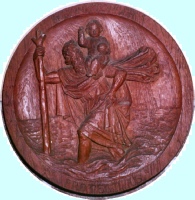

Personal accounts of people who served at HMS St Christopher
From the biography of Georges Marcil, written by his wife Eileen:
For his part, George left for small craft training, three weeks at HMS St. Christopher, Fort William, Inverness, on Loch Linnhe (pronounced Linny), in Scotland, followed by three at Ardrishaig, on Loch Gilp, an inlet of Loch Fyne.
At Fort William, both officers and men learned about the mechanics of coastal craft, especially the B class Fairmile Motor Launches, of which there were a number at the base, and how to handle them. However, no chances were taken on their crashing one into a wharf or anther boat. They practised coming alongside a lifebelt thrown overboard in the middle of the loch. On completion of the training there, Georges went on to the anti-submarine School at Ardrishaig, where he took the course for officers detailed for anti-submarine duties, and for which a submarine of sorts was kept in the loch.
Excerpt from an email to Derrick Warner:
Following a recent visit to Fort William I heard of your web site about HMS St Christopher where my mother was during the war doing code and cypher things. My father spent 2 years at Corpach doing civil engineering projects to establish the navy base. I believe he was involved amongst other things in building a set of 7 dams to assist the water supply. My parents were married in St Andrews church on 14th October 1943.
Major Walker C.O. 'F' Coy R.M. Engineers (best man), Lieut Commander McEwen (gave the bride away) Sgt G.B. Mackay 'F' Coy R.M. Engineers, Wren J.F. Bevan, Wren D. Cooper (bridesmaid) and 3rd officer Cooke WRNS…
During his time at Corpach he was billeted in the old village hall. It has since been demolished and there are several new houses on the site which is now called Albyn Terrace.
My mother was based at Fort William for 2 years. She spent time in Oban and Kyle of Lochalsh with the Navy. She went on to Blundelsands in Liverpool to also undertake officer training and went on to be a master at arms in the fleet air arm on the Isle of Man. On her wedding day she borrowed a dress from a friend in Fort William as did her bridesmaid!
Regards, Sheila Forrest
From the BBC Peoples War Web site regarding Roland Clark:
Our journey by train to Fort William seemed endless. Thursday, 21st May (1942), early morning start, arrived early evening the following day at H.M.S. St. Christopher. The only thing I remember was the stations for refreshments all laid on and most of all the Jam Jars containing tea. I wouldn't advise anyone to visit there in May - we were there for three weeks and it rained continuously, except the Sundays. Our billets were Nissan Huts in the grounds of the Highland Hotel (St. Christopher). The Hotel was officers' quarters and classrooms for instruction on the routines and living and working on small craft. The half dozen Fairmile Motor Launches and a Motor Torpedo Boat on Loch Linnhe were for the ratings and officers to acquaint themselves with, as these craft were to be their home for the duration. We would assemble on board in the morning after being marched down to the jetty to the tune of Bagpipes. The M.L'S would set off S.W. down the Loch, turn to starboard up through the Sound of Mull out into the open sea above the Isle of Mull. We would be having instruction on Stokers duties in the engine room, how to deal with Depth Charges and how to set. Keep in touch with Semaphoring. Taking Tricks at the Helm. Knowing the duties of a Lookout and the correct way of describing and position of what you have seen. The Gunners would have a shoot at an odd wreck or two with a prehistoric breech loading Hodgkiss Two Pounder Gun. Aircraft recognition of friendly and enemy. Silhouette shapes of surface craft. How to deal with collision damage. The tasks were many but interesting.
After divisions on Sunday the rest of the time was a free day and what ! it was fine. I was still with my two pals I had made at Ganges - Jinks and Woolerton. So we set off on each Sunday down the Vale of Nevis and up the footpath to the summit of Ben Nevis. On the third Sunday we were very lucky, we had just arrived at the summit when there was a blizzard, it did make it difficult to descend. All that came to a halt, for the following Saturday, the 12th June, back on the train at noon to H.M.S. Bee which was still at Weymouth, just dropped in nicely for Sunday tea, with a draft chit awaiting me also for the next day to ? ? Felixstowe.
Debbie R Brown
